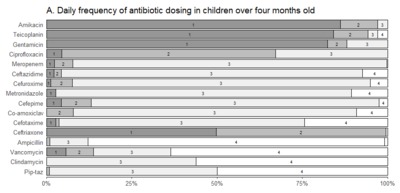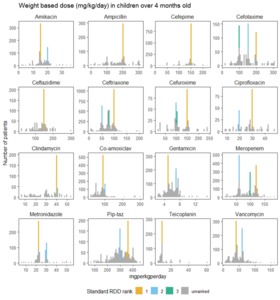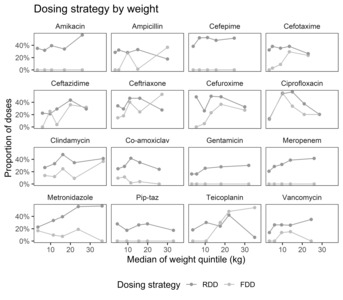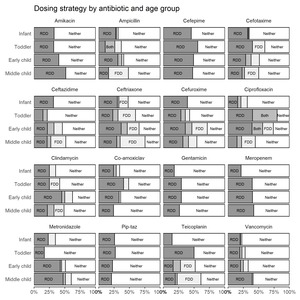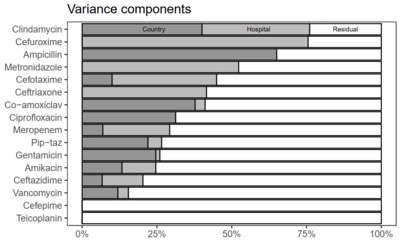Clements, MN; Russell, N; Bielicki, JA; Ellis, S; Gastine, S; Hsia, Y; Standing, JF; Walker, AS; Sharland, M
(2021)
Global antibiotic dosing strategies in hospitalised children: Characterising variation and implications for harmonisation of international guidelines.
PLoS One, 16 (5).
e0252223.
ISSN 1932-6203
https://doi.org/10.1371/journal.pone.0252223
SGUL Authors: Hsia, Yingfen Russell, Neal James Bielicki, Julia Anna Sharland, Michael Roy
|
PDF
Published Version
Available under License Creative Commons Attribution. Download (2MB) | Preview |
|
![[img]](https://openaccess.sgul.ac.uk/113275/8.hassmallThumbnailVersion/journal.pone.0252223.s001.png)
|
Image (PNG) (S1 Fig)
Accepted Version
Available under License Creative Commons Attribution. Download (17kB) | Preview |
|
![[img]](https://openaccess.sgul.ac.uk/113275/13.hassmallThumbnailVersion/journal.pone.0252223.s002.png)
|
Image (PNG) (S2 Fig)
Published Version
Available under License Creative Commons Attribution. Download (450kB) | Preview |
|
![[img]](https://openaccess.sgul.ac.uk/113275/20.hassmallThumbnailVersion/journal.pone.0252223.s003.png)
|
Image (PNG) (S3 Fig)
Published Version
Available under License Creative Commons Attribution. Download (645kB) | Preview |
|
![[img]](https://openaccess.sgul.ac.uk/113275/25.hassmallThumbnailVersion/journal.pone.0252223.s004.png)
|
Image (PNG) (S4 Fig)
Published Version
Available under License Creative Commons Attribution. Download (342kB) | Preview |
|
![[img]](https://openaccess.sgul.ac.uk/113275/30.hassmallThumbnailVersion/journal.pone.0252223.s005.png)
|
Image (PNG) (S5 Fig)
Published Version
Available under License Creative Commons Attribution. Download (99kB) | Preview |
|
|
Microsoft Word (.docx) (S1 Appendix)
Published Version
Available under License Creative Commons Attribution. Download (12kB) |
||
|
Microsoft Excel (S1 Data)
Published Version
Available under License Creative Commons Attribution. Download (679kB) |
||
|
Microsoft Word (.docx) (S1 Table)
Published Version
Available under License Creative Commons Attribution. Download (13kB) |
||
|
Microsoft Word (.docx) (S2 Table)
Published Version
Available under License Creative Commons Attribution. Download (13kB) |
||
|
Microsoft Word (.docx) (S3 Table)
Published Version
Available under License Creative Commons Attribution. Download (13kB) |
||
|
Microsoft Word (.docx) (S4 Table)
Published Version
Available under License Creative Commons Attribution. Download (13kB) |
||
|
Microsoft Word (.docx) (S5 Table)
Published Version
Available under License Creative Commons Attribution. Download (13kB) |
||
|
Microsoft Word (.docx) (S6 Table)
Published Version
Available under License Creative Commons Attribution. Download (13kB) |
||
|
Microsoft Word (.docx) (S7 Table)
Published Version
Available under License Creative Commons Attribution. Download (74kB) |
||
|
Microsoft Word (.docx) (S8 Table)
Published Version
Available under License Creative Commons Attribution. Download (14kB) |
||
|
Microsoft Word (.docx)
Accepted Version
Available under License Creative Commons Attribution. Download (540kB) |
Abstract
Background Paediatric global antibiotic guidelines are inconsistent, most likely due to the limited pharmacokinetic and efficacy data in this population. We investigated factors underlying variation in antibiotic dosing using data from five global point prevalence surveys. Methods & findings Data from 3,367 doses of the 16 most frequent intravenous antibiotics administered to children 1 month–12 years across 23 countries were analysed. For each antibiotic, we identified standard doses given as either weight-based doses (in mg/kg/day) or fixed daily doses (in mg/day), and investigated the pattern of dosing using each strategy. Factors underlying observed variation in weight-based doses were investigated using linear mixed effects models. Weight-based dosing (in mg/kg/day) clustered around a small number of peaks, and all antibiotics had 1–3 standard weight-based doses used in 5%-48% of doses. Dosing strategy was more often weight-based than fixed daily dosing for all antibiotics apart from teicoplanin, which had approximately equal proportions of dosing attributable to each strategy. No strong consistent patterns emerged to explain the historical variation in actual weight-based doses used apart from higher dosing seen in central nervous system infections, and lower in skin and soft tissue infections compared to lower respiratory tract infections. Higher dosing was noted in the Americas compared to the European region. Conclusions Antibiotic dosing in children clusters around a small number of doses, although variation remains. There is a clear opportunity for the clinical, scientific and public health communities to consolidate behind a consistent set of global antibiotic dosing guidelines to harmonise current practice and prioritise future research.
| Item Type: | Article | ||||||
|---|---|---|---|---|---|---|---|
| Additional Information: | Copyright: © 2021 Clements et al. This is an open access article distributed under the terms of the Creative Commons Attribution License (http://creativecommons.org/licenses/by/4.0/), which permits unrestricted use, distribution, and reproduction in any medium, provided the original author and source are credited. | ||||||
| Keywords: | MD Multidisciplinary, General Science & Technology | ||||||
| SGUL Research Institute / Research Centre: | Academic Structure > Infection and Immunity Research Institute (INII) | ||||||
| Journal or Publication Title: | PLoS One | ||||||
| ISSN: | 1932-6203 | ||||||
| Language: | eng | ||||||
| Dates: |
|
||||||
| Publisher License: | Creative Commons: Attribution 4.0 | ||||||
| Projects: |
|
||||||
| PubMed ID: | 34043696 | ||||||
 |
Go to PubMed abstract | ||||||
| URI: | https://openaccess.sgul.ac.uk/id/eprint/113275 | ||||||
| Publisher's version: | https://doi.org/10.1371/journal.pone.0252223 |
Statistics
Actions (login required)
 |
Edit Item |


